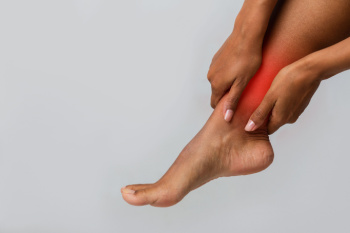
Ankle tendonitis is inflammation of the tendons around the ankle joint, often caused by overuse, improper footwear, flat feet, or sudden increases in physical activity. Common types include Achilles tendonitis, posterior tibial tendonitis, and peroneal tendonitis. Symptoms may involve aching, swelling, stiffness, and tenderness along the affected tendon, especially after activity or in the morning. The area may appear red or warm and can become painful when walking, climbing stairs, or standing for long periods. The pain is usually localized but can radiate along the ankle or lower leg. A podiatrist can diagnose the specific type of tendonitis through a physical examination, medical history, and imaging studies, such as ultrasound or MRI. Treatment may include anti-inflammatory medications, custom orthotics, targeted exercises, and temporary immobilization. In more severe cases, advanced therapies or surgery may be needed. Since untreated tendonitis can lead to chronic pain or tendon rupture, it is suggested that you make an appointment with a podiatrist.
Ankle pain can be caused by a number of problems and may be potentially serious. If you have ankle pain, consult with Adam Klein, DPM from Lynbrook, NY. Our practitioner will assess your condition and provide you with quality foot and ankle treatment.
Ankle pain is any condition that causes pain in the ankle. Due to the fact that the ankle consists of tendons, muscles, bones, and ligaments, ankle pain can come from a number of different conditions.
Causes
The most common causes of ankle pain include:
- Types of arthritis (rheumatoid, osteoarthritis, and gout)
- Ankle sprains
- Broken ankles
- Achilles tendonitis
- Achilles tendon rupture
- Stress fractures
- Bursitis
- Tarsal tunnel syndrome
- Plantar fasciitis
Symptoms
Symptoms of ankle injury vary based upon the condition. Pain may include general pain and discomfort, swelling, aching, redness, bruising, burning or stabbing sensations, and/or loss of sensation.
Diagnosis
Due to the wide variety of potential causes of ankle pain, podiatrists will utilize a number of different methods to properly diagnose ankle pain. This can include asking for personal and family medical histories and of any recent injuries. Further diagnosis may include sensation tests, a physical examination, and potentially x-rays or other imaging tests.
Treatment
Just as the range of causes varies widely, so do treatments. Some more common treatments are rest, ice packs, keeping pressure off the foot, orthotics and braces, medication for inflammation and pain, and surgery.
If you have any questions please feel free to contact our office located in Contact Us . We offer the newest diagnostic tools and technology to treat your foot and ankle needs.
